Analysis of Non-Road Mobile Machinery Homologation Standards in Relation to Actual Exhaust Emissions
Abstract
:1. Introduction
2. Railway Passenger Rolling Stock in Poland
3. Legal Regulations Regarding Testing and Approval of Non-Road Vehicles
- Directive 97/68/EC of 16 December 1997 (as amended), which contains provisions on emission standards and procedures for the approval of engines installed in non-road machines [19];
- Directive 2004/26EC of 21 April 2004 (as amended), which amends Directive 97/68/EC in order to bring members of the community closer to reducing emissions from combustion engines [27];
- Regulation 2016/1628 of the European Parliament and of the EU Council of 14 September 2016, which repeals Directive 97/68/EC, introducing the Stage V emission standard [28].
- The concentration in the raw exhaust gas can be determined by integrating the exhaust gas analyzer signal in accordance with the procedure described in the Directive [33];
- In the undiluted exhaust gas in a Constant Volume Sample (CVS) system, diluting the total flow by integration or collecting a sample into bags in accordance with the procedure described in the Directive [33].
- nnor is the normalized rotational speed,
- nidle is the idle speed, and
- nref is the reference speed calculated according to the formula:
- n50 is the minimum speed at which the engine reaches 50% of its rated power, and
- n70 is the maximum speed at which the engine reaches 70% of the rated power.
- Then, the torque is denormalized and determined based on formula:where:Mo = (%Monor × Momax)/100
- Monor is the normalized torque, and
- Momax is the maximum torque.
4. Research Methodology
4.1. Research Object
4.2. Measuring Equipment
4.3. Research Route
5. Research Results
5.1. Introduction to Analysis
5.2. Analysis of Operating Parameters in the Aspect of Applicable Approval Tests
5.3. Analysis of Emissions of Toxic Compounds in Real Operating Conditions from a Combustion Railbus
- j is a toxic compound for which an emission factor has been determined,
- ereal,j are specific emissions determined from tests in real operating conditions (g/kWh), and
- elimit,j are permissible specific emissions in accordance with standards (g/kWh).
6. Conclusions
- The specific nature of the operation of rail vehicles, their large population, and the power of the drive units used in them play a significant role in the impact on the natural environment;
- The characteristics of the share of the research facility’s operating time in actual operation showed that the largest share in the traffic of these vehicles is its standstill, the value of which was 30.00% compared with the value of 2.34% for the NRTC approval test. The difference is therefore 27.7%, so steps are necessary to modify the applicable laboratory test for vehicles of this category, with particular emphasis on the engine operating characteristics during typical passenger transport (numerous stops at railway stops);
- The analysis of the determined differences between the values of the operating time share for real conditions and the NRTC approval test showed that the largest values of individual intervals were 27.62% (idle speed) and 24.08% for the average crankshaft rotational speed and the largest interval of torque values. Significant discrepancies prove that the applicable approval tests are unrepresentative and that they need to be modified for the group of machines in question or the testing legislation in real operating conditions;
- The measurements of rail vehicles were carried out in real operating conditions, which is an original research methodology for this group of vehicles. Current approvals for off-road vehicles are performed only for engines in special laboratory conditions, which makes it impossible to obtain reliable information on the impact of various external factors (Figure 19). This is confirmed by the results obtained. A comparative analysis of road emission factors determined on the basis of tests in real operating conditions with the permissible values of homologation tests showed significant exceedances of HC and NOx limits;
- The presented scheme for carrying out measurements in real operating conditions should be continued in order to obtain the actual emissions of a vehicle that can operate in various conditions. Thanks to field tests, it is possible to measure and relate the obtained results of emissions of harmful compounds to atmospheric conditions, vehicle traffic parameters, the number of passengers, etc.
Author Contributions
Funding
Data Availability Statement
Conflicts of Interest
References
- Andrews, G.E.; Li, H.; Wylie, J.A.; Zhu, G.; Bell, M.; Tate, J. Influence of Ambient Temperature on Cold-Start Emissions for a Euro 1 SI Car Using In-Vehicle Emissions Measurement in an Urban Traffic Jam Test Cycle; Society of Automotive Engineers: Warrendale, PA, USA, 2005. [Google Scholar]
- Li, H.; Andrews, G.E.; Zhu, G.; Daham, B.; Bell, M.; Tate, J.; Ropkins, K. Impact of ambient temperatures on exhaust thermal characteristics during cold start for real world si car urban driving tests (No. 2005-01-3896). SAE Tech. Pap. 2005, 1, 3896. [Google Scholar]
- Samuel, S.; Morrey, D.; Fowkes, M.; Taylor, D.H.C.; Austin, L.; Felstead, T.; Latham, S. The most significant vehicle operating parameter for real-world emission levels. SAE Trans. 2004, 113, 407–425. [Google Scholar]
- Andr’e, M. The ARTEMIS European driving cycles for measuring car pollutant emissions. Sci. Total Environ. 2004, 334–335, 73–84. [Google Scholar] [CrossRef] [PubMed]
- Stahel, W.; Pritscher, L.; De Haan, P. Neues EMPA-Standardmessprogramm, Sonderuntersuchung der “Real-World”-Fahrzyklen; BUWAL: Bern, Switzerland, 2000. [Google Scholar]
- World Health Organization. World Health Statistics 2023: Monitoring Health for the SDGs, Sustainable Development Goals; World Health Organization: Geneva, Switzerland, 2023. [Google Scholar]
- European Environment Agency. Greenhouse Gas Emissions from Transport in Europe, 2022; European Environment Agency: Copenhagen, Denmark, 2023. [Google Scholar]
- Latha, H.; Prakash, K.; Veerangouda, M.; Maski, D.; Ramappa, K. A Review on Scr System for Nox Reduction in Diesel Engine. Int. J. Curr. Microbiol. Appl. Sci. 2019, 8, 1553–1559. [Google Scholar] [CrossRef]
- Bajerlein, M.; Karpiuk, W.; Smolec, R. Use of Gas Desorption Effect in Injection Systems of Diesel Engines. Energies 2021, 14, 244. [Google Scholar] [CrossRef]
- Bor, M.; Borowczyk, T.; Idzior, M.; Karpiuk, W.; Smolec, R. Analysis of Hypocycloid Drive Application in a High-Pressure Fuel Pump. EDP Sci. 2017, 118, 00020. [Google Scholar] [CrossRef]
- Lijewski, P.; Merkisz, J.; Fuc, P.; Kozak, M.; Rymaniak, L. Air Pollution by the Exhaust Emissions from Construction Machinery under Actual Operating Conditions. Appl. Mech. Mater. 2013, 390, 313–319. [Google Scholar] [CrossRef]
- Merkisz, J.; Idzior, M.; Lijewski, P.; Fuc, P.; Karpiuk, W. The Analysis of the Quality of Fuel Spraying in Relation to Selected Rapeseed Oil Fuels for the Common Rail System. In Proceedings of the Ninth Asia-Pacific International Symposium on Combustion and Energy Utilization, Beijing, China, 2–6 November 2008; pp. 352–356. [Google Scholar]
- Merkisz, J.; Mizera, J.; Bajerlein, M.; Rymaniak, L.; Maj, P. The Influence of Laser Treatment and the Application of Reduced Pressure Force Piston Rings on the Engine Exhaust Emissions under the Conditions of Engine Lubrication with Different Engine Oils. Appl. Mech. Mater. 2014, 518, 102–107. [Google Scholar] [CrossRef]
- Rymaniak, L.; Daszkiewicz, P.; Merkisz, J.; Bolzhelarskyi, Y.V. Method of Determining the Locomotive Engine Specific Fuel Consumption Based on Its Operating Conditions. AIP Publ. 2019, 2078, 1. [Google Scholar]
- Sawczuk, W.; Jüngst, M.; Ulbrich, D.; Kowalczyk, J. Modeling the Depth of Surface Cracks in Brake Disc. Materials 2021, 14, 3890. [Google Scholar] [CrossRef]
- Sawczuk, W.; Merkisz-Guranowska, A.; Rilo Cañás, A.-M. Assessment of Disc Brake Vibration in Rail Vehicle Operation on the Basis of Brake Stand. Eksploatacja i Niezawodność 2021, 23, 2. [Google Scholar] [CrossRef]
- Sawczuk, W.; Merkisz-Guranowska, A.; Ulbrich, D.; Kowalczyk, J.; Cañás, A.-M.R. Investigation and Modelling of the Weight Wear of Friction Pads of a Railway Disc Brake. Materials 2022, 15, 6312. [Google Scholar] [CrossRef]
- Tomaszewski, S.; Tomaszewski, F.; Stawecki, W.; Urbański, P.; Far, M.; Bolzhelarskyi, Y. Optimization of the Design of Relay Valves for Rail Vehicles Braking Systems in the Context of Train Traffic Safety. EDP Sci. 2019, 294, 03013. [Google Scholar] [CrossRef]
- European Union. EC Directive 97/68/EC of the European Parliament and of the Council. Off. J. Eur. Union 1997, L 353, 2–286. [Google Scholar]
- Jaworski, A.; Mateichyk, V.; Kuszewski, H.; Mądziel, M.; Woś, P.; Babiarz, B.; Śmieszek, M.; Porada, S. Towards Cleaner Cities: An Analysis of the Impact of Bus Fleet Decomposition on PM and NOX Emissions Reduction in Sustainable Public Transport. Energies 2023, 16, 6956. [Google Scholar] [CrossRef]
- Balogh, R.; Ionel, I. Experimental Approach Concerning the Selective Catalytic Reduction of NOx for Diesel Engines of Romanian Railway Transport. Optoelectron. Adv. Mater. Rapid Commun. 2011, 5, 1123–1129. [Google Scholar]
- Picus, C.M.; Mihai, I.; Suciu, C. Experimental Investigations upon Ultrasound Influence on Calefaction of AdBlue in Selective Catalytic Reduction Systems (SCR). Micromachines 2023, 14, 1488. [Google Scholar] [CrossRef]
- www.utk.gov.pl. Available online: https://dane.utk.gov.pl/sts/przewozy-pasazerskie/dane-eksploatacyjne/21369,Przewozy-pasazerskie.html (accessed on 18 June 2024).
- www.utk.gov.pl. Available online: https://dane.utk.gov.pl/sts/przewozy-pasazerskie/tabor-pasazerski/16737,Tabor-kolejowy-przewoznikow-pasazerskich.html (accessed on 16 June 2024).
- International Union of Railways UIC 624 Railway Code. Research on Exhaust Gas Emissions of Traction Combustion Engines; International Union of Railways: Paris, France, 2006. [Google Scholar]
- International Union of Railways UIC 623-2 Railway Code. Homologation Tests of Combustion Engines of Propulsion Vehicles; International Union of Railways: Paris, France, 2005. [Google Scholar]
- European Union. EC Directive 2004/26/EC of the European Parliament and of the Council of 21 April 2004 Amending Directive 97/68. Off. J. Eur. Union 2004, L 225, 3–107. [Google Scholar]
- European Union. EP Committee Regulation 2016/1628 of the European Parliament and of the EU Council of 14 September 2016, Which Repeals Directive 97/68/EC, Introducing the Stage V Emission Standard 2021. Available online: https://eur-lex.europa.eu/eli/reg/2016/1628/oj (accessed on 16 June 2024).
- DieselNet Emission Standards, European Union: Nonroad Engines; European Union: Brussels, Belgium. Available online: https://dieselnet.com/standards/#eu (accessed on 16 June 2024).
- Merkisz, J.; Siedlecki, M. Specific Emissions Analysis for a Combustion Engine in Dynamometer Operation in Relation to the Thermal State of the Exhaust Gas Aftertreatment Systems in a Modified NRSC Test. EDP Sci. 2017, 118, 00027. [Google Scholar] [CrossRef]
- Siedlecki, M.; Lijewski, P.; Weymann, S. Analysis of Tractor Particulate Emissions in a Modified NRSC Test after Implementing a Particulate Filter in the Exhaust System. EDP Sci. 2017, 118, 00028. [Google Scholar] [CrossRef]
- Siedlecki, M.; Szymlet, N.; Fuć, P.; Kurc, B. Analysis of the Possibilities of Reduction of Exhaust Emissions from a Farm Tractor by Retrofitting Exhaust Aftertreatment. Energies 2022, 15, 7963. [Google Scholar] [CrossRef]
- European Union. COMMISSION DIRECTIVE 2010/26/EU of 31 March 2010 Amending Directive 97/68/EC of the European Parliament and of the Council on the Approximation of the Laws of the Member States Relating to Measures against the Emission of Gaseous and Particulate Pollutants from Internal Combustion Engines to be Installed in Non-Road Mobile Machinery; European Union: Brussels, Belgium, 2010. [Google Scholar]
- European Union. COMMISSION DIRECTIVE 2012/46/EU of 6 December 2012 Amending Directive 97/68/EC of the European Parliament and of the Council on the Approximation of the Laws of the Member States Relating to Measures against the Emission of Gaseous and Particulate Pollutants from Internal Combustion Engines to be Installed in Non-Road Mobile Machinery; European Union: Brussels, Belgium, 2012. [Google Scholar]
- Bajerlein, M.; Rymaniak, L. The Reduction of Fuel Consumption on the Example of Ecological Hybrid Buses. Appl. Mech. Mater. 2014, 518, 96–101. [Google Scholar] [CrossRef]
- Lijewski, P.; Merkisz, J.; Ziółkowski, A.; Rymaniak, Ł. Analiza Emisji Gazów Wylotowych Wyznaczonej w Teście NTE z Ciężkiego Pojazdu Samochodowego Na Podstawie Badań Przeprowadzonych w Rzeczywistych Warunkach Jego Eksploatacji. Combust. Engines 2013, 52, 696–700. [Google Scholar]
- Merkisz, J.; Pielecha, J. Nanoparticle Emissions from Combustion Engines; Springer: New York, NY, USA, 2015; ISBN 3-319-15928-3. [Google Scholar]
- Merkisz, J.; Pielecha, J.; Pielecha, I. Road Test Emissions Using On-Board Measuring Method for Light Duty Diesel Vehicles. Jordan J. Mech. Ind. Eng. 2011, 5, 89–96. [Google Scholar]
- Rymaniak, L. Comparison of the Combustion Engine Operating Parameters and the Ecological Indicators of an Urban Bus in Dynamic Type Approval Tests and in Actual Operating Conditions. EDP Sci. 2017, 118, 00009. [Google Scholar] [CrossRef]
- Szymlet, N.; Lijewski, P.; Sokolnicka, B.; Siedlecki, M.; Domowicz, A. Analysis of Research Method, Results and Regulations Regarding the Exhaust Emissions from Two-Wheeled Vehicles under Actual Operating Conditions. J. Ecol. Eng. 2020, 21, 1. [Google Scholar] [CrossRef]
- Rosero, F.; Fonseca, N.; López, J.-M.; Casanova, J. Real-World Fuel Efficiency and Emissions from an Urban Diesel Bus Engine under Transient Operating Conditions. Appl. Energy 2020, 261, 114442. [Google Scholar] [CrossRef]
- Rymaniak, L.; Ziolkowski, A.; Gallas, D. Particle Number and Particulate Mass Emissions of Heavy Duty Vehicles in Real Operating Conditions. EDP Sci. 2017, 118, 00025. [Google Scholar] [CrossRef]
- Bajerlein, M.; Rymaniak, L.; Swiatek, P.; Ziolkowski, A.; Daszkiewicz, P.; Dobrzynski, M. Modification of a Hybrid City Bus Powertrain in the Aspect of Lower Fuel Consumption and Exhaust Emissions. Appl. Mech. Mater. 2014, 518, 108–113. [Google Scholar] [CrossRef]
- Markowski, J.; Pielecha, J.; Jasiński, R.; Kniaziewicz, T.; Wirkowski, P. Development of Alternative Ship Propulsion in Terms of Exhaust Emissions. EDP Sci. 2016, 10, 00140. [Google Scholar] [CrossRef]
- Mądziel, M. Instantaneous CO2 Emission Modelling for a Euro 6 Start-Stop Vehicle Based on Portable Emission Measurement System Data and Artificial Intelligence Methods. Environ. Sci. Pollut. Res. 2024, 31, 6944–6959. [Google Scholar] [CrossRef]
- Mądziel, M. Modelling CO2 Emissions from Vehicles Fuelled with Compressed Natural Gas Based on On-Road and Chassis Dynamometer Tests. Energies 2024, 17, 1850. [Google Scholar] [CrossRef]
- Rymaniak, Ł.; Kamińska, M.; Szymlet, N.; Grzeszczyk, R. Analysis of Harmful Exhaust Gas Concentrations in Cloud behind a Vehicle with a Spark Ignition Engine. Energies 2021, 14, 1769. [Google Scholar] [CrossRef]
- GlobalMRV Axion R/S+ PEMS. Available online: https://www.globalmrv.com/products/axion-rs-2-pems/ (accessed on 12 July 2024).
- www.gov.uk. Available online: https://www.gov.uk/government/statistics/air-quality-statistics/ntrogen-dioxide (accessed on 12 July 2024).
- Rymaniak, Ł. Analiza Wpływu Rodzaju Układu Napędowego i Parametrów Ruchu Autobusów Miejskich Na Ekologiczne Wskaźniki Pracy. Ph.D. Thesis, Politechnika Poznańska, Poznań, Poland, 2016; 137p. [Google Scholar]
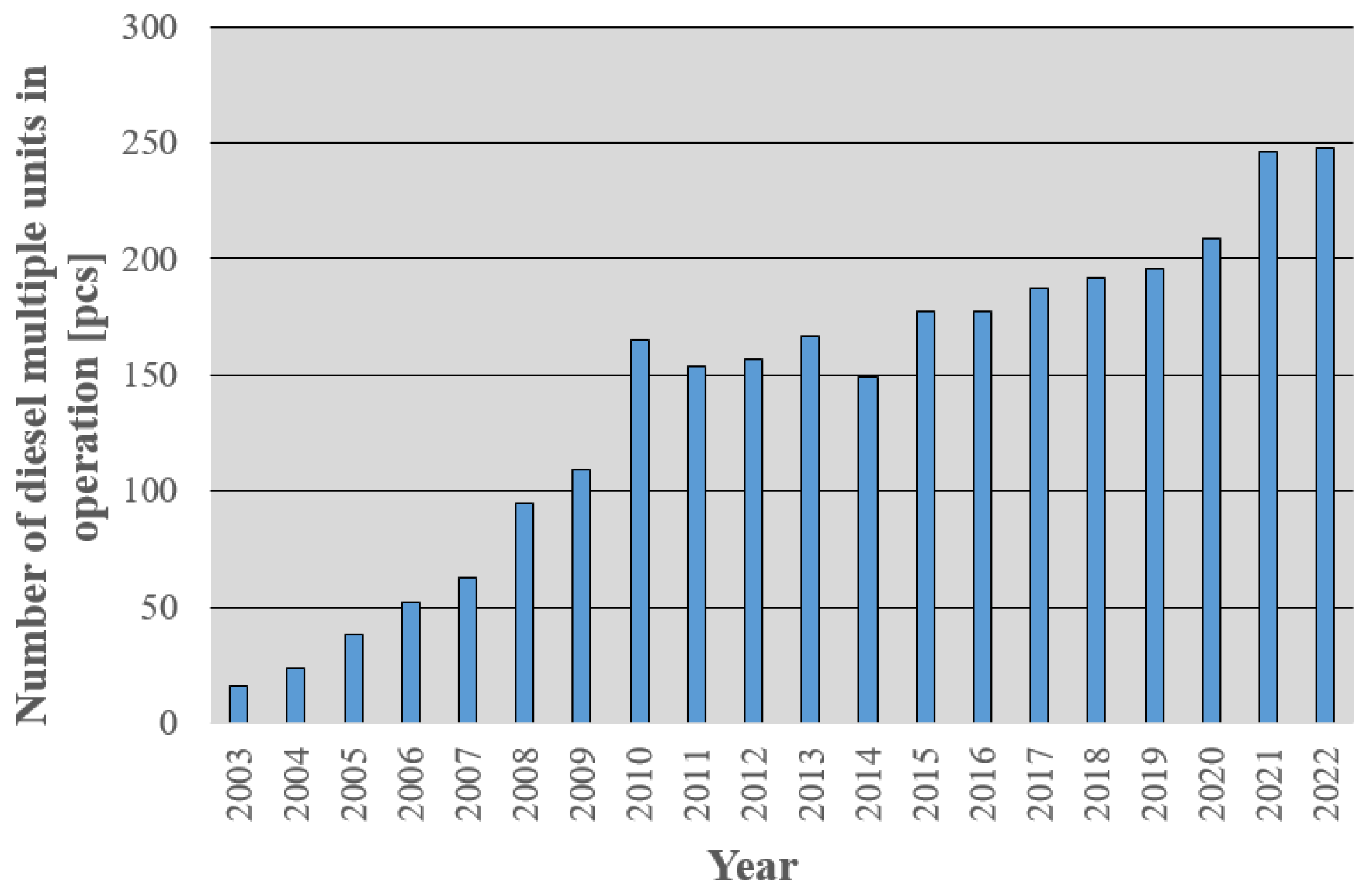
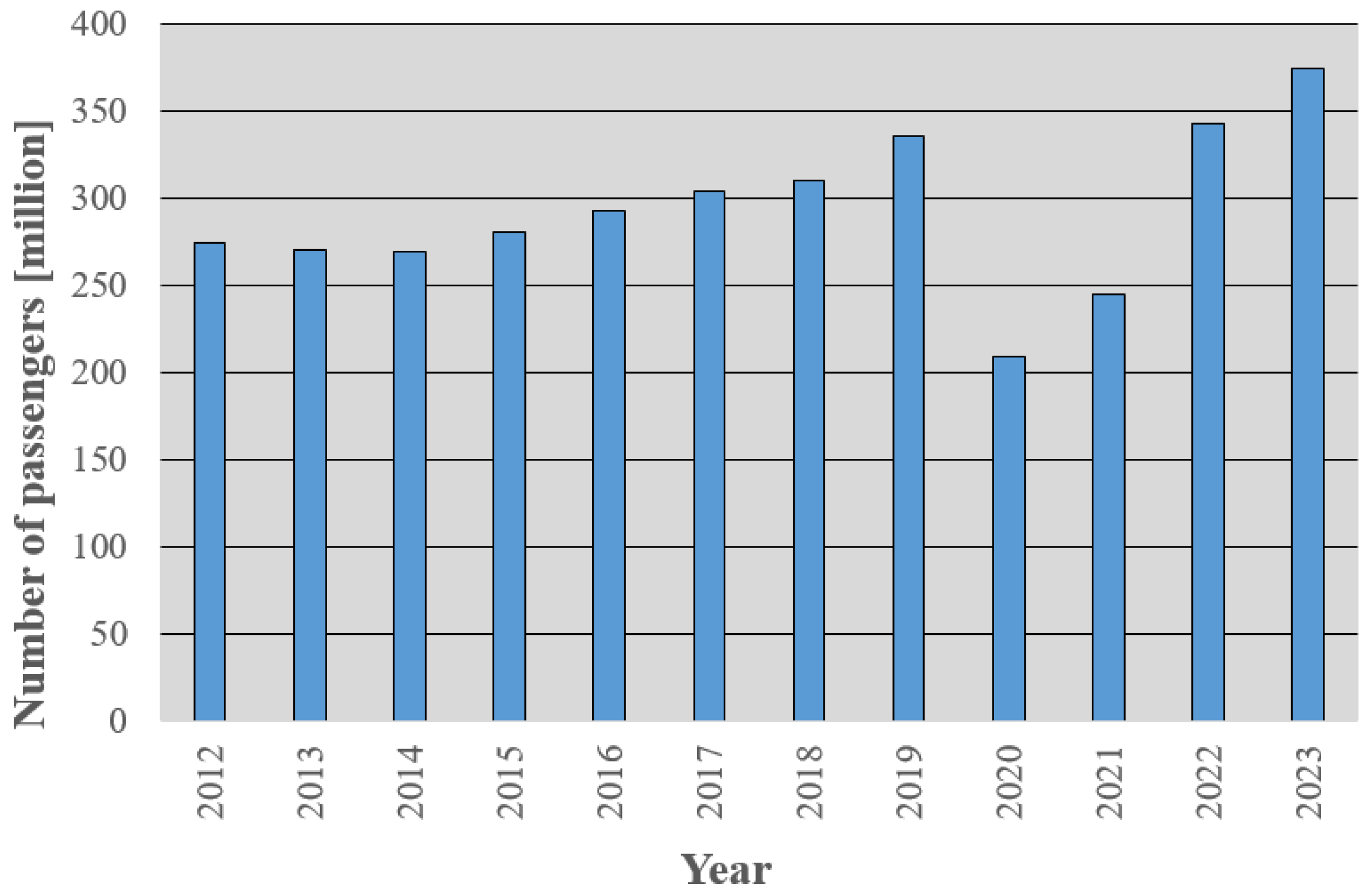

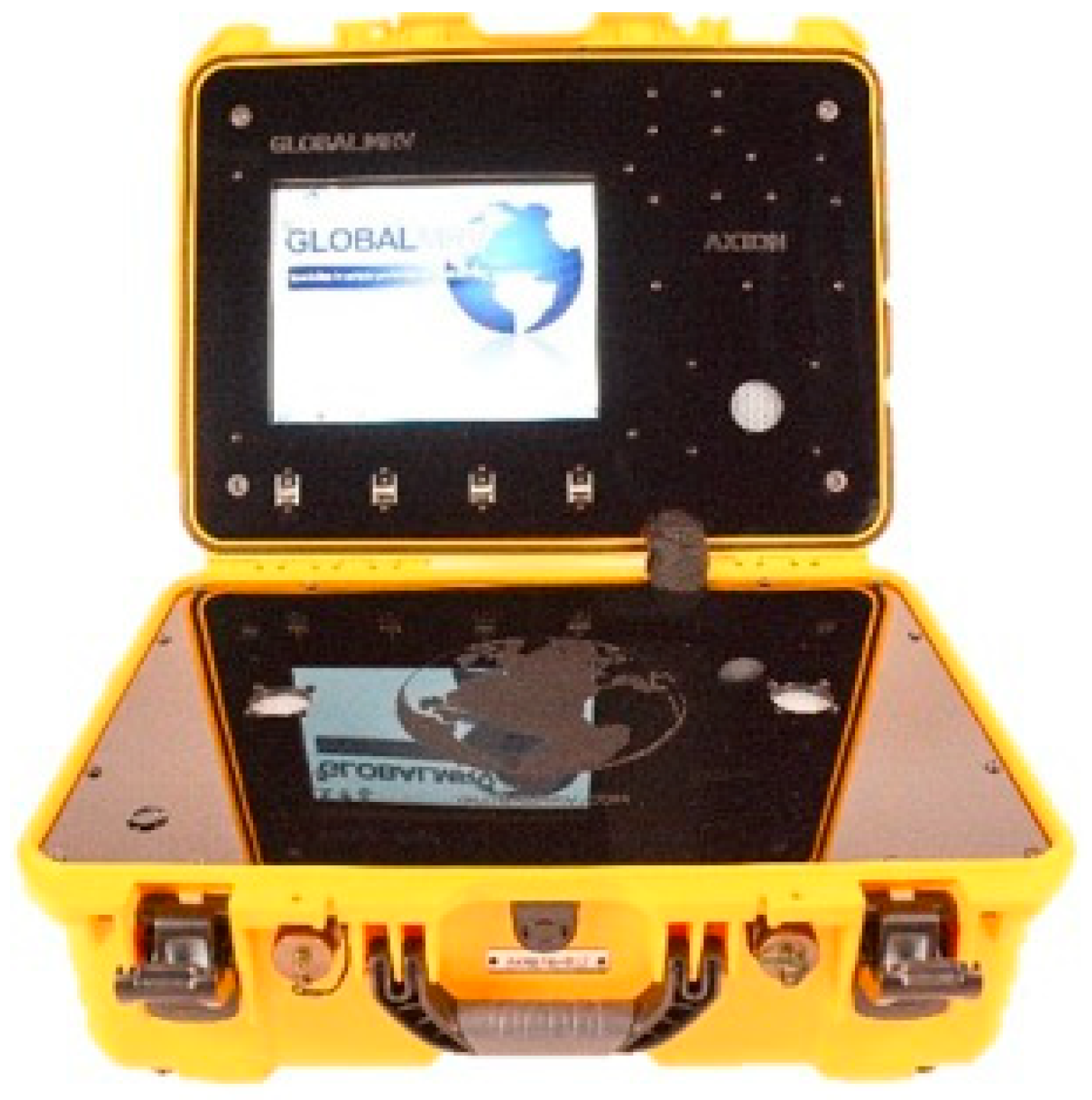

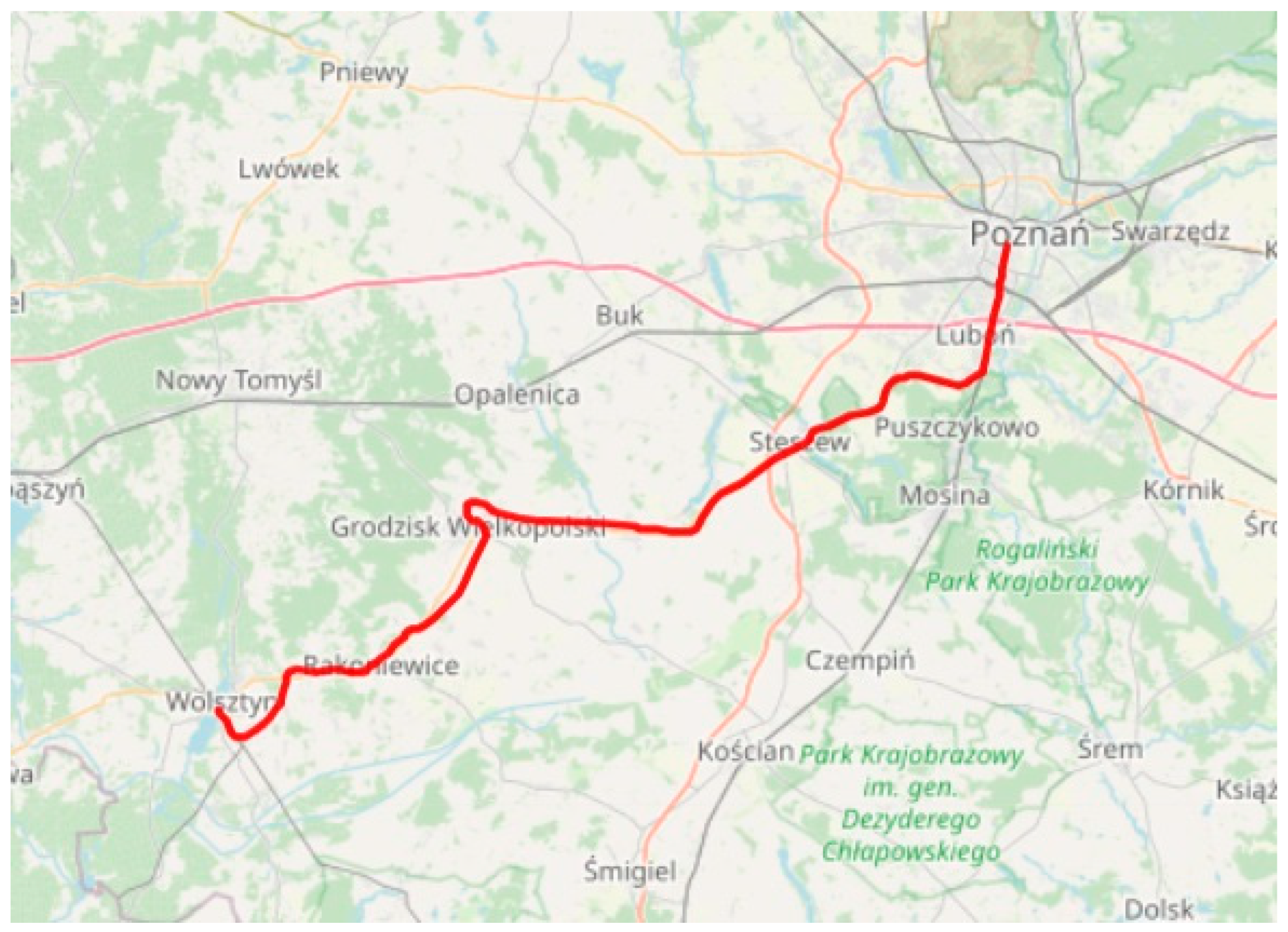


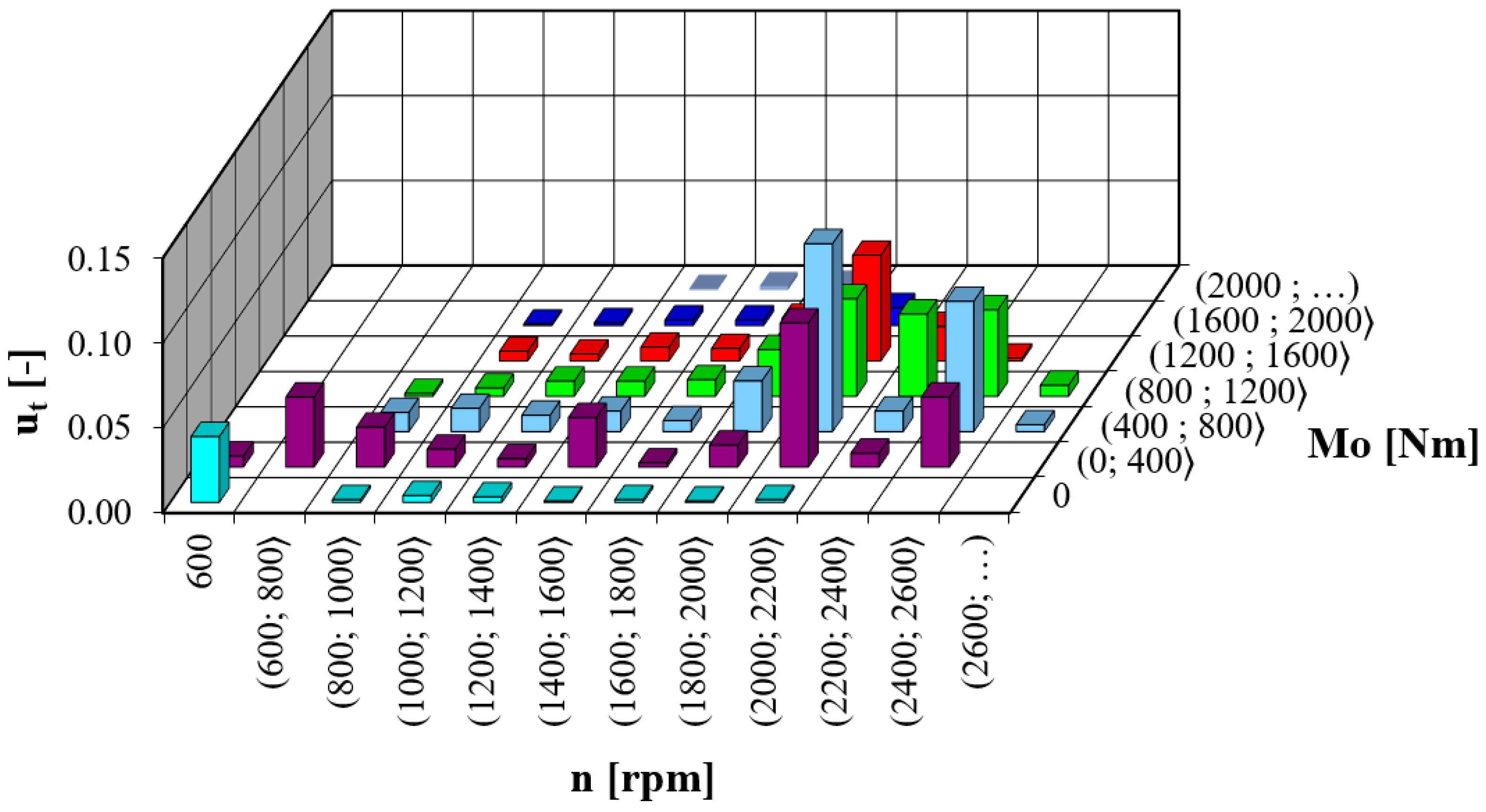


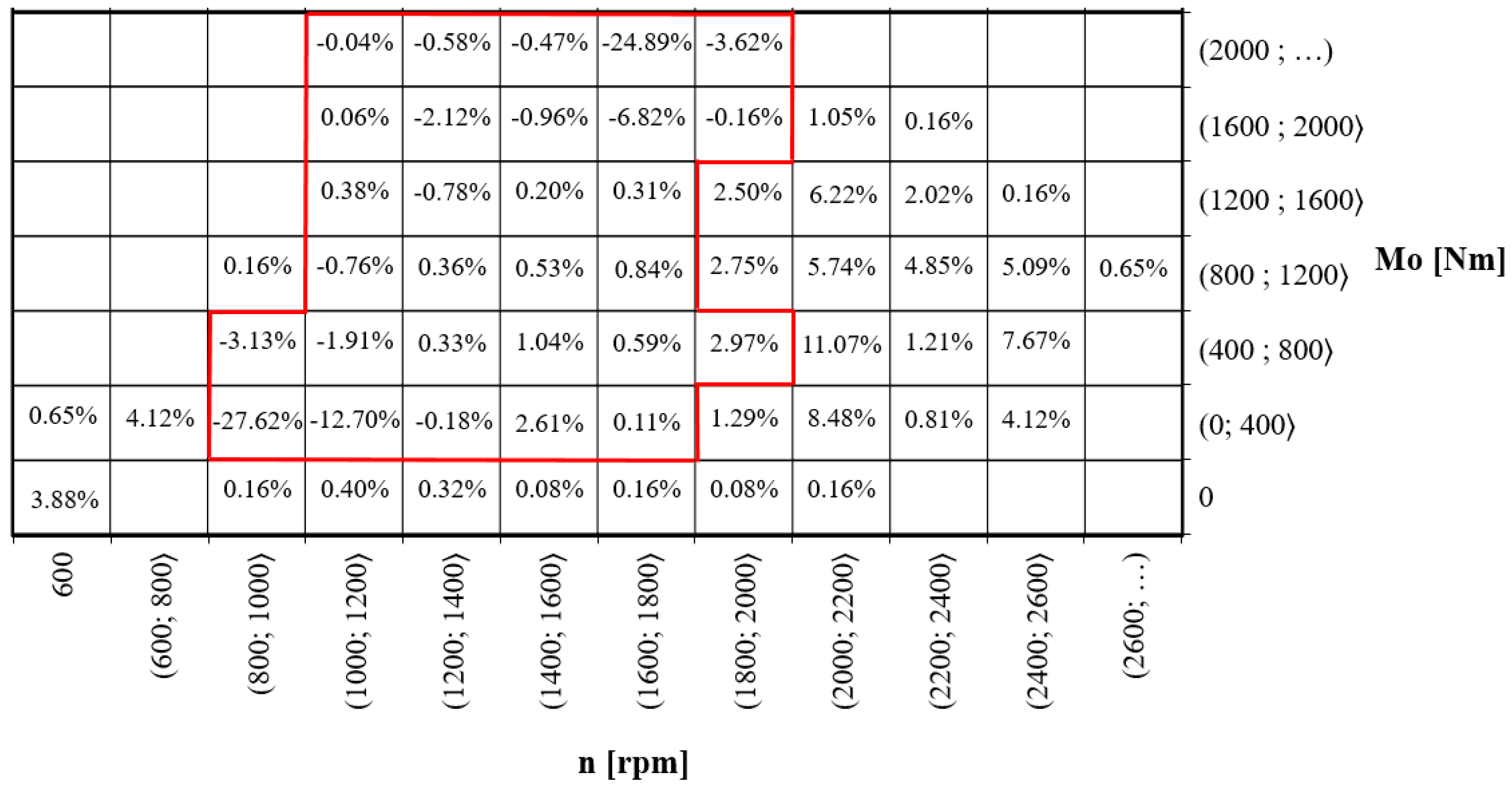
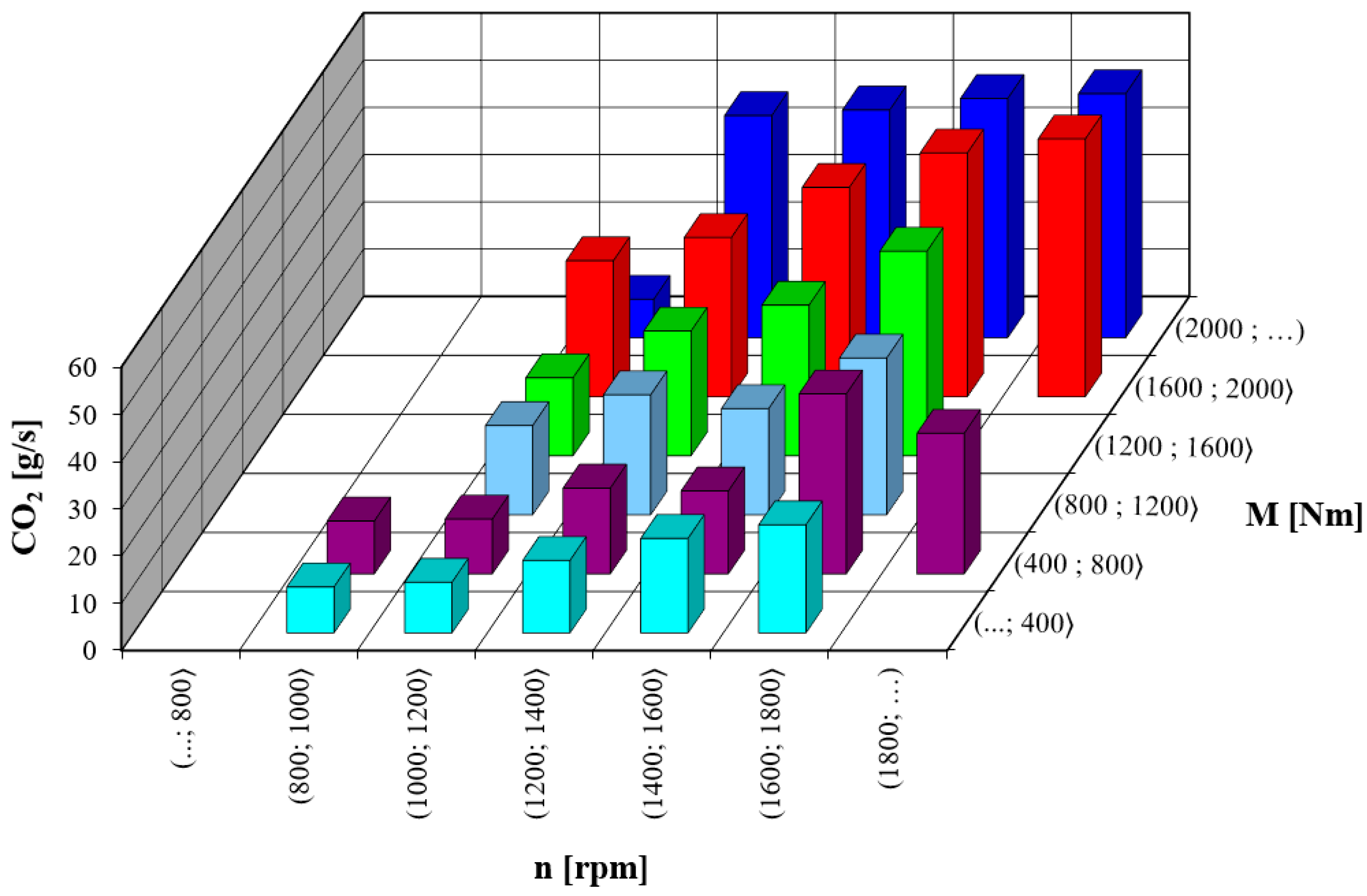
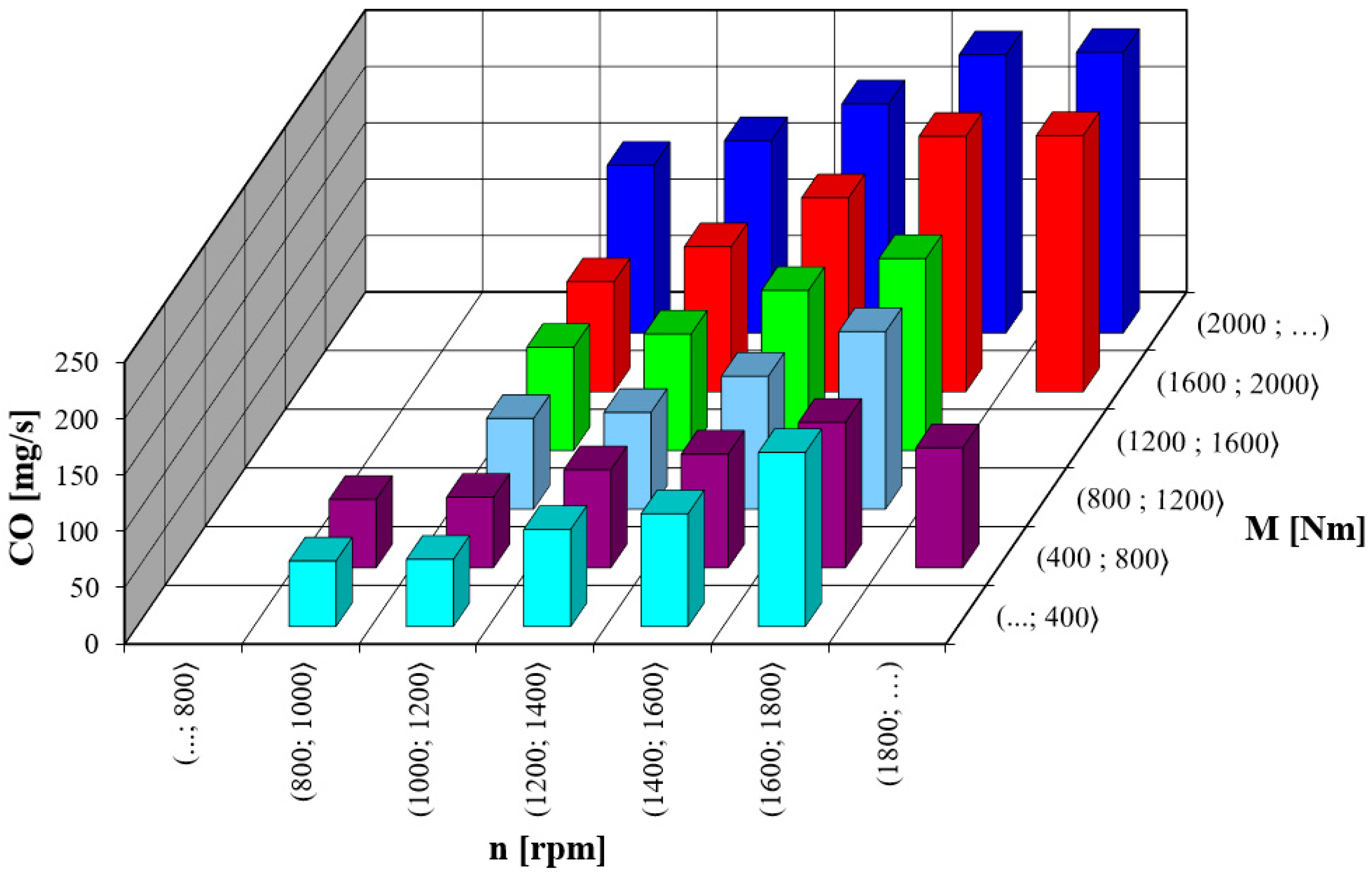




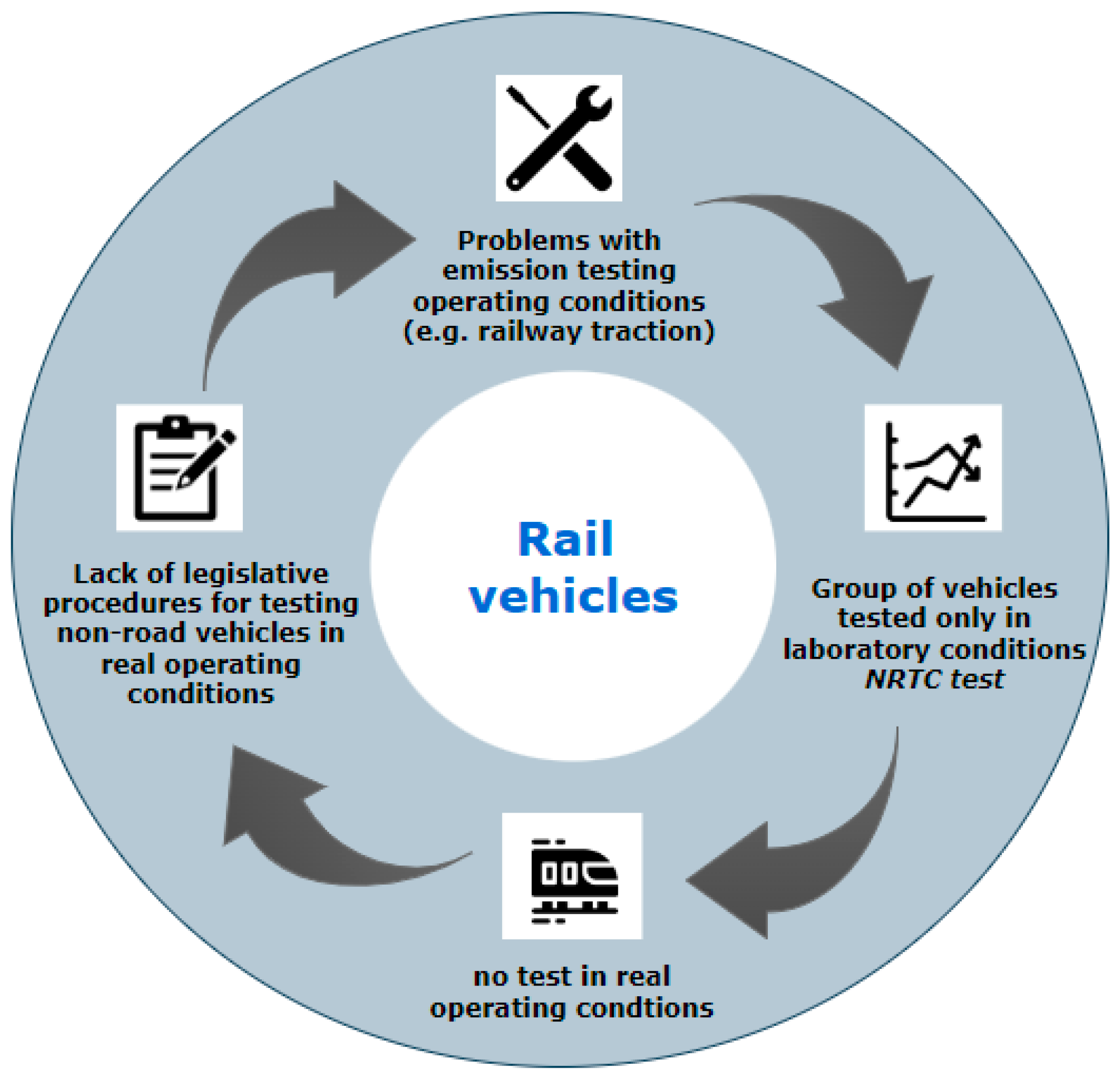
| Date of Introduction | Emission (g/kWh) | |||
|---|---|---|---|---|
| CO | NOx | HC | PM | |
| Until 31 December 2002 UIC I | 3 | 12 | 0.8 | 1.6 |
| From 1 January 2003 UIC II | 2.5 | 6 | 0.6 | 0.25 |
| p ≤ 560 kW | 9.5 (n > 1000 rpm) | |||
| p > 560 kW | 3 | 9.9 (n ≤ 1000 rpm) | 0.8 | 0.25 |
| From 1 January 2003 | ||||
| p ≤ 560 kW | 2 | 4.6 | 0.5 | 0.15 |
| p > 560 kW | 2 | 6 | 0.5 | 0.2 |
| Date of Introduction | Emission (g/kWh) | ||||
|---|---|---|---|---|---|
| CO | HC | NOx | PM | ||
| Stage I | 1999 | 5.0 | 1.3 | 9.2 | 0.54 |
| Stage II | 2002 | 3.5 | 1.0 | 6.0 | 0.2 |
| Stage IIIA | 2006 | 3.5 | 4.0 | 0.2 | |
| Stage IIIB | 2011 | 3.5 | 0.19 | 2.0 | 0.025 |
| Stage IV | 2014 | 3.5 | 0.19 | 0.4 | 0.025 |
| Stage V | 2019 | 3.5 | 0.19 | 0.4 | 0.015 |
| Exhaust Component | Measurement Range | Measurement Accuracy | Distribution | Type of Measurement | Measurement Time (s) |
|---|---|---|---|---|---|
| CO2 | 0–16% | ±0.3% absolute ±4% relative | 0.01 vol.% | NDIR | <3.5 |
| CO | 0–10% | ±0.02% absolute ±3% relative | 0.001 vol.% | NDIR | <3.5 |
| HC | 0–4000 ppm | ±8 ppm absolute ±3% relative | 1 ppm | NDIR | <3.5 |
| NO * | 0–4000 ppm | ±25 ppm absolute ±3% relative | 1 ppm | E-chem | <5 |
| PM | 0–300 mg/m3 | ±2% | 0.01 mg/m3 | Laser Scatter | 2 |
Disclaimer/Publisher’s Note: The statements, opinions and data contained in all publications are solely those of the individual author(s) and contributor(s) and not of MDPI and/or the editor(s). MDPI and/or the editor(s) disclaim responsibility for any injury to people or property resulting from any ideas, methods, instructions or products referred to in the content. |
© 2024 by the authors. Licensee MDPI, Basel, Switzerland. This article is an open access article distributed under the terms and conditions of the Creative Commons Attribution (CC BY) license (https://creativecommons.org/licenses/by/4.0/).
Share and Cite
Szymlet, N.; Kamińska, M.; Ziółkowski, A.; Sobczak, J. Analysis of Non-Road Mobile Machinery Homologation Standards in Relation to Actual Exhaust Emissions. Energies 2024, 17, 3624. https://doi.org/10.3390/en17153624
Szymlet N, Kamińska M, Ziółkowski A, Sobczak J. Analysis of Non-Road Mobile Machinery Homologation Standards in Relation to Actual Exhaust Emissions. Energies. 2024; 17(15):3624. https://doi.org/10.3390/en17153624
Chicago/Turabian StyleSzymlet, Natalia, Michalina Kamińska, Andrzej Ziółkowski, and Jakub Sobczak. 2024. "Analysis of Non-Road Mobile Machinery Homologation Standards in Relation to Actual Exhaust Emissions" Energies 17, no. 15: 3624. https://doi.org/10.3390/en17153624
APA StyleSzymlet, N., Kamińska, M., Ziółkowski, A., & Sobczak, J. (2024). Analysis of Non-Road Mobile Machinery Homologation Standards in Relation to Actual Exhaust Emissions. Energies, 17(15), 3624. https://doi.org/10.3390/en17153624










